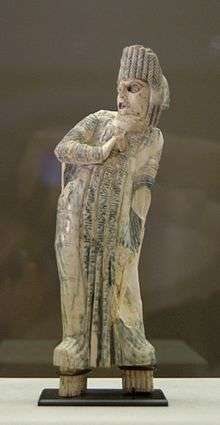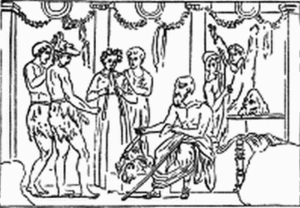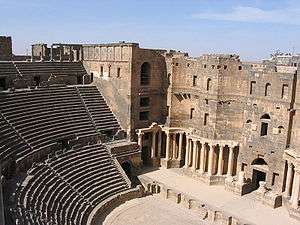Theatre of ancient Rome
Theatre of ancient Rome refers to the time period of theatrical practice and performance in Rome beginning in the 4th century B.C., following the state’s transition from Monarchy to Republic.[1] Theater of the era is generally separated into the genres of drama and comedy, with only Roman comedic plays having survived to present day.
Origins of Roman theatre
Rome was founded in 753 B.C.E as a monarchy under Etruscan rule, and remained as such throughout the first two and a half centuries of its existence. Following the expulsion of Rome's last king, Lucius Tarquinius Superbus, or "Tarquin the Proud," circa 509 B.C.E., Rome became a Republic, and was henceforth led by a group of magistrates elected by the Roman people. It is believed that Roman theatre was born during the first two centuries of the Roman Republic, following the spread of Roman rule into a large area of the Italian peninsula, circa 364 B.C.E.
Following the devastation of widespread plague in 364 B.C.E, Roman citizens began including theatrical games as a supplement to the Lectisternium ceremonies already being performed, in a stronger effort to pacify the gods. In the years following the establishment of these practices, actors began adapting these dances and games into performances by acting out texts set to music and simultaneous movement.
As the era of the Roman Republic progressed, citizens began including professionally performed drama in the eclectic offerings of the ludi (celebrations of public holidays) held throughout each year -- the largest of these festivals being the Ludi Romani, held each September in honor of the Roman god Jupiter.[2] It was as a part of the Ludi Romani in 240 B.C.E. that author and playwright Livius Adronicus became the first to produce translations of Greek plays to be performed on the Roman stage.[1]
Genres of ancient Roman theatre

The first important works of Roman literature were the tragedies and comedies written by Livius Andronicus beginning in 240 BC. Five years later, Gnaeus Naevius also began to write drama, also composing in both genres. No plays from either writer have survived. By the beginning of the 2nd century BC, drama had become firmly established in Rome and a guild of writers (collegium poetarum) had been formed.[3]
Roman tragedy
No early Roman tragedy survives, though it was highly regarded in its day; historians know of three early tragedians—Quintus Ennius, Marcus Pacuvius and Lucius Accius. From the time of the empire, the work of two tragedians survives—one is an unknown author, while the other is the Stoic philosopher Seneca. Nine of Seneca's tragedies survive, all of which are fabula crepidata (tragedies adapted from Greek originals); his Phaedra, for example, was based on Euripides' Hippolytus.[4] Historians do not know who wrote the only extant example of the fabula praetexta (tragedies based on Roman subjects), Octavia, but in former times it was mistakenly attributed to Seneca due to his appearance as a character in the tragedy.[3]
Roman comedy
All Roman comedies that have survived can be categorized as fabula palliata (comedies based on Greek subjects) and were written by two dramatists: Titus Maccius Plautus (Plautus) and Publius Terentius Afer (Terence).[3]
In adapting Greek plays to be performed for Roman audiences, the Roman comic dramatists made several changes to the structure of the productions. Most notable is the removal of the previously prominent role of the chorus as a means of separating the action into distinct episodes. Additionally, musical accompaniment was added as a simultaneous supplement to the plays' dialogue. The action of all scenes typically took place in the streets outside the dwelling of the main characters, and plot complications were often a result of eavesdropping by a minor character.
Plautus wrote between 205 and 184 B.C. and twenty of his comedies survive to present day, of which his farces are best known. He was admired for the wit of his dialogue and for his varied use of poetic meters.[5] All six of the comedies that Terence composed between 166 and 160 BC have survived. The complexity of his plots, in which he routinely combined several Greek originals into one production, brought denouncement upon his practices, but his double-plots enabled a sophisticated presentation of contrasting human behaviour.[3]
Stock characters in Roman comedy

Stock characters in Roman comedy include:
- The adulescens is the hero, who is young, rich, love-struck and not too brave. He tends to bemoan his fate and requires backup. Another character often has to take action on his behalf. His father is often the senex or an old man, whom he fears but does not respect. He wears a dark wig and his clothes are usually crimson.
- The senex has several incarnations. As the father he is either too strict or too soft; both characteristics come from a love for his son. As the lover he embarrasses his son, his slave, and his wife. He tends to be passionately in love with the same woman as his son, a woman who is much too young for the senex. He never gets the girl and is often dragged off by his irate wife. Sometimes he is a friend of the family who helps the adulescens. He is often a miser, who wears a straight, white undergarment with long doubled sleeves and sometimes carries a staff.
- The leno runs the brothel. The love interest of the adulescens may be owned by the leno and work at his brothel, so that the adulescens is often forced to deal with him. The leno is unabashedly amoral and only interested in money. He dresses in a tunic and mantel, and is often bald and carries a moneybag.
- The miles gloriosus, literally braggart soldier, is a character that is especially familiar today. He loves himself more than anything else and sees himself as handsome and brave, while in reality he is very stupid, cowardly, and gullible. He may be interested in the same girl as the adulescens. He wears a tunic with long sleeves and has curly hair.
- The parasitus or parasite lives only for himself. He is often seen begging for meals or being refused them. He lies for his own gain. He dresses in a long, black or gray garment with long, doubled sleeves.
- The servi (slaves) take up about half of the cast and often have the most monologues. They are not the toilers typical of a real Roman home. The servus callidus or clever slave is always talkative, but his other traits vary. Most of the time he is loyal, more so to the adulescens than the senex. He brings tricks and comedy to the play, and tends to drive the plot. He is often the one who finds the truth out at the end of the play. He can be identified by his tendency to use alliteration and meter in his speech. The servi wear tunics and hold or carry scarves.
- The ancilla is a maid or nurse of no particular age. She is a minor character used to move the plot by presenting information or helping to develop another character. She is a tool of her mistress and may be used as a messenger.
- The matrona (mother), mulier (woman), or uxor (wife) is shrewd. She loves her children, but is temperamental towards her husband. She does not have to be a devoted wife, but sometimes is. She wears a long garment with flowing sleeves and a mantle.
- The meretrix (prostitute) is either mercenary or devoted. The first type is older or more experienced and has seen a lot. The second type is truly in love with the adulescens. Both are very attractive with a complex hairdo and outfit, which is yellow. She also has a mantel.
- The virgo (young maiden) is the love interest of the adulescens, but does not get much stage time. She is beautiful and virtuous with little personality. She is treated as a prize.
Roman theatre in performance
Stage and physical space
The Roman theatre was laid out like a Greek theatre. There was a backstage area, seating arrangements for the audience, and an orchestra. The Roman stage went through many different stages before reaching the form we all recognize today.
Theatres started out as simple, temporary wooden structures. The layout of the stage was the same as in later stone stages: three doors, opening to the brothel, temple, and hero's house. The stage itself was enclosed by wings at each side, and the scene house had a roof.
The Romans did not have a permanent (stone) theatre until the final years of the Republic; the latest reference to the Romans' building a new theater was in 17 BC. The large stone theatres seated tens of thousands of Romans. There was no front curtain nor were performances done in the orchestra pit (unlike Greek plays). The audiences sat on temporary wooden benches where there was room; ushers would direct the patrons all throughout the performance.
Actors

Roman actors had bad reputations and their morals challenged even the decadence of Roman society. Their performances could be lewd, highly sexual and offensive. They could also be highly critical of the political status quo. As expected, some emperors were as critical of them and took certain measures in an attempt to counteract their influence: Emperor Julian the Apostate forbade the pagan Roman priests from attending theatrical performances to avoid giving the performances respectability, and the more enlightened Emperor Tiberius would not allow people of the stage to have any contact with the upper classes. Most Roman plays were whimsical, more mimes and pantomimes than drama; the "classics" were in the minority.
In the early Roman Republic (before the emperors emerged after Julius Caesar), women did not enter the profession; it was considered inappropriate for them. However, in the Imperial period, a number of women became famous actresses, and earned reputations as infamous as their male counterparts. Indeed, one of the Emperor Nero’s concubines, Acte, was an actress.
Over the years, a number of actors became quite influential, counting among their friends men of high standing within Roman society. Some gifted theatrical artists such as Roscius, in comedy, and Aesopus, in tragedy, earned considerable reputations and were fêted by the Romans. Indeed, the Christian St. Genesius had a respectable reputation and was considered a gifted writer, actor and comedian, even by the Emperor Diocletian who was present at the performance in which he was converted.

Notable Roman playwrights
- Livius Andronicus, a Greek slave taken to Rome in 240 BCE, who wrote plays based on Greek theatre. Rome's first playwright
- Plautus, 3rd century BC comedic playwright and writer of Miles Gloriosus, Pseudolus, and Menaechmi
- Terence, who wrote between 170 and 160 BC
- Gaius Maecenas Melissus, 1st century playwright of a "comedy of manners"
- Seneca, 1st century dramatist most famous for Roman adaptations of ancient Greek plays like Medea and Phaedra
- Ennius, contemporary of Plautus who wrote both comedies and tragedies
- Lucius Accius, tragic poet and literary scholar
- Pacuvius, Ennius's nephew and tragic playwright
See also
- History of theatre
- Theatre of ancient Greece
- Roman theatre (structure)
- Atellan farce
- Roman funerals and burial
- Ludi
- Floralia
- Latin literature
- Theatre Area of Pompeii
Notes
- 1 2 Moore, Timothy J. (2012). Roman Theatre. Cambridge University Press. ISBN 9780521138185.
- ↑ Zarrilli, Phillip B. (2006). Theatre Histories: An Introduction. Routledge. p. 102. ISBN 978-0-415-22728-5.
- 1 2 3 4 Brockett and Hildy (2003, 47-50).
- ↑ Brockett and Hildy (2003, 49–50).
- ↑ Brockett and Hildy (2003, 48).
Sources
- Banham, Martin (1995). The Cambridge Guide to Theatre. Cambridge University Press. ISBN 978-0-521-43437-9.
- Richard C. Beacham (1991). The Roman Theatre and Its Audience. Harvard University Press. ISBN 978-0-674-77914-3.
- Oscar Brockett; Franklin J. Hildy (2002). History of the Theatre. ISBN 978-0-205-41050-7.
- Timothy J. Moore (2012). Roman Theatre. Cambridge University Press. ISBN 978-0-521-13818-5.
- Phillip B. Zarrilli; Bruce McConachie; Gary Jay Williams; Carol Fisher Sorgenfrei (2006). Theatre Histories: An Introduction. Routledge. ISBN 978-0-415-22728-5.
External links
- The Ancient Theatre Archive, Greek and Roman theatre architecture - Dr. Thomas G. Hines, Department of Theatre, Whitman College
- Cliff, U.The Roman Theatre, Clio History Journal, 2009.
- Roman Theater, Roman Colosseum, 2008.

